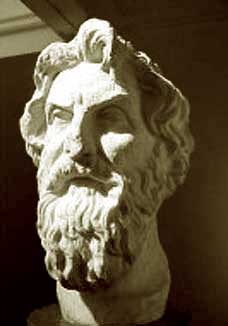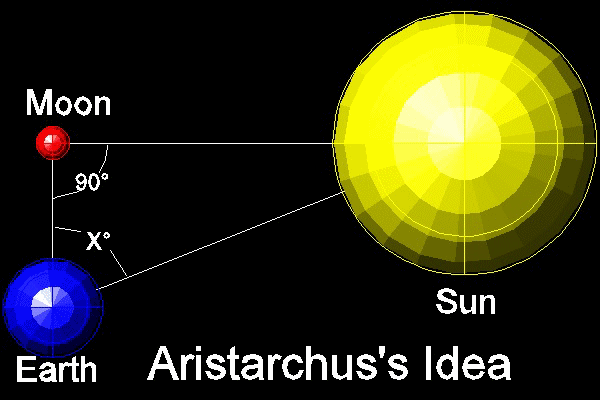Aristarchus of Samos
Aristarchus (os) of Samos (Greek Ἀρίσταρχος; * around 310 BC in Samos; † around 230 BC) was a Greek astronomer and mathematician.
He was a pupil of Strato of Lampsacus and one of the first Greek astronomer who represented the heliocentric world view, according to which the Sun, not the Earth was at the center of the universe. Therefore, he is regarded as the " Greek Copernicus ". He pushed with his theory but hardly for recognition (exception: Seleucus of Seleucia ), so that his ideas were overshadowed by the works of Aristotle and Ptolemy. It was not until about 1800 years later they were rediscovered by Copernicus and picked up again.
Heliocentric world picture
The only work of Aristarchus, which has been preserved until today, is titled On the sizes and distances of the sun and moon and still based on the geocentric worldview. But we know by later citations of other scholars, that he represented the hypothesis of a heliocentric world view in another book. So Archimedes writes in his sand account:
" You, O king Gelon, you know that the universe ' which astronomers call that sphere whose center is the earth, where its radius the distance between the center of the sun and the center of the earth corresponds. This is the general view, as you have heard from astronomers. Aristarchus but has written a book consisting of certain hypotheses, and, inferentially from these assumptions, shows that the universe is many times greater than the universe ', which I have just mentioned. His theses are that the fixed stars and the sun are immovable, that the Earth moves around the Sun on the circumference of a circle, where the sun is in the center of this orbit, and that the sphere of fixed stars, whose center this sun and within which the earth moves, such a large extent has that the distance from the earth to the sphere equals the distance of the sphere to its center. "
Aristarchus thinks far ahead here, if not the earth but the sun is in the center, so we would actually observe a parallax. The appearance of the night sky would have to depend on the current position during a revolution of the earth around the sun change. In fact, this parallax is less than a second of arc and therefore not detectable with the naked eye, even with the sun coming stars. This seemingly lack of parallax was the main argument against Aristarchus model. He explained by an inconceivably large distance to the fixed stars, opposite the diameter of Earth's orbit is vanishingly small. The stellar parallax was until 1838 detected by telescopes.
What consequences this might have pulled itself, suggests Plutarch in the dialog over the moon face:
" Cleanthes [ a contemporary of Aristarchus ] believed it was the duty of the Greeks, Aristarchus of Samos to accuse for impiety, that he had added to the hearth of the universe [ the earth ] in motion, as he tried to save the phenomena by he assumed that the sky would be in peace and the earth moves in an oblique circle and rotate it around its own axis. "
Size of the moon
Aristarchus watched as the moon moved through the Earth's shadow during a lunar eclipse. He concluded that the diameter of the Earth is 2.85 times as large as that of the moon. In fact, this factor is about 3.67.
Distance to the Sun
Aristarchus realized that the crescent moon caused when sunlight falls exactly perpendicular to our line of sight to the moon. The triangle sun, moon, earth thus has at half moon form a right angle on:
The size of the angle between the sun and moon Aristarchus has experimentally determined to at least 87 °. By drawing a right triangle with an angle of 87 ° can now be the ratio of the distances Earth-Sun and Earth-Moon determine. Nowadays, you can calculate trigonometric to 1/cos (87 ° ) ≈ 19.1 this ratio, of course. Thus we have shown that the sun is at least 19 times so far away from Earth as the moon.
In fact, the sun is as far away as 400 times of the earth as the moon. This corresponds to an angle of approximately 89 ° 51 '. That is the same time that seen from the Sun, Earth and Moon only nine minutes of angle appear apart.
Aristarchus has surely noticed that the angle is close to 90 °. The aim of the measurement had to in this case the answer to the question will be: How big the angle is at least? Only this information can be a reliable statement about the minimum distance of the sun derived.
Aristarchus original works have the time unfortunately did not survive; they are known only from the quotations and comments from followers. Since the sun and moon in the sky appear great about the same, Aristarchus concluded that its actual size is also at least a factor 19 would differ from each other. This difference the reasons mentioned is indeed in truth 400 times. But alone, that Aristarchus believes the sun needed to be far greater than the earth, was an important indication of the theory that such a large celestial body must also be located in the center of the universe - if the sun is not as Aristarchus opponents argue from mass Wi ether exists.

.jpeg/220px-Aristarchos_von_Samos_(Denkmal).jpeg)








